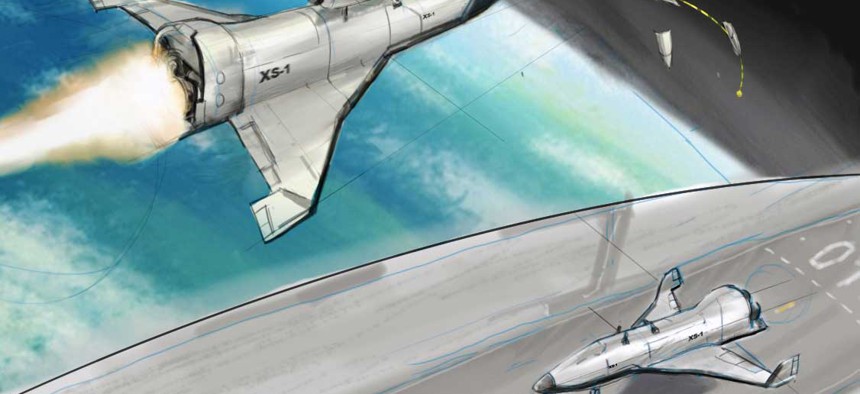
An artist's rendition of the XS-1 space plane DARPA
Big Data, Synthetic Biology and Space Planes Are the Weapons of the Future
DARPA’s FY15 budget is full of more money for cutting-edge capabilities like big data, synthetic biology and space planes. By Patrick Tucker
What are the military’s cutting-edge capabilities of the next decade? According to the Defense Advanced Research Projects Agency, it’s big data, synthetic biology and space planes.
“We can see the information revolution unfolding across operations,” DARPA Director Arati Prabhakar told the House Armed Services Committee at a hearing on the FY2015 budget on Wednesday. She emphasized that it was very important to create “new tools to help us get a handle on the explosion of data.”
Amid the budget crisis in Washington, as the Defense Department is “doing more with less” after more than a decade of war, DARPA is one of the few agencies that’s seeing an increase in parts of its budget.
DARPA’s budget (PDF) reveals a growing focus not on new data sources but on developing entirely new and far-fetched methods for processing it.
The agency is requesting $13 million in FY 2015 for a program to build a so-called “models of the brain,” an increase of about $2 million from this year’s budget. The program will “establish a functional mathematical basis on which to build future advances in cognitive neuroscience, computing capability, and signal processing across the DOD. An important focus of this program will be determining how information is stored and recalled in the brain and other DOD-relevant signals and developing predictive, quantitative models of learning, memory, and measurement.”
DARPA’s Big Mechanism program will create “new approaches to automated computational intelligence applicable to diverse domains such as biology, cyber, economics, social science, and intelligence." It saw its spending increased to triple in FY2015 to $15 million. There’s also more money for quantum computing research—up to $31 million from $23 million.
The agency is looking beyond bits to bugs, of the biological variety. One of the key new programs highlighted in the budget is the ACE program in Advanced Capabilities in Engineering Biology. The program seeks to create “new chemicals and materials, sensing capabilities, therapeutics, and numerous other applications,” will receive $8 million in funding to develop novel biological materials.
“We see biology intersect with engineering and we see the seeds of technological surprise,” Prabhakar told the committee. She discussed the importance of basic research in the biological sciences in other institutions as key to DARPA’s ability to develop new technologies and insights from cutting-edge breakthroughs. “All of us rely on a larger national ecosystem,” she said. “We are building on top of basic research from [National Institutes of Health] or National Science Foundation. We find places to build national security implications on top of that.”
Biological warfare defense will increase to $44.8 from $24.5 million. Among the other DARPA winners: sensor technology research saw an increase to $312 million from $276 million.
The agency is also allocating an additional $27.5 million for the development of the XS-1 reusable space plane that could carry objects into low-earth orbit multiple times, at a cost of less than $5 million per launch.
(Related; It’s Becoming Too Expensive for the Military to Go Into Space)
In her written testimony to the committee, Prabhakar flushed out the value of that program. “Imagine a world in which getting a satellite into orbit can be as quick and reliable as an aircraft takeoff. Our new Experimental Space Plane is designed to take a 3,000- to 5,000-pound payload into orbit using an expendable upper stage, all for under $5 million; that is one-tenth the cost of a comparable launch today. Our [air land and sea application] program focuses on 100-pound payloads for less than $1 million. Even more striking is our goal of providing satellite launches for these payloads with just 24 hours’ notice.”
When asked by the Committee Vice Chairman Mac Thornberry, R-Texas, how the agency tracked rapid technology change, Prabhakar said she didn’t have “a magic answer.”
A big part of her job, she said, was encouraging her program managers to “get out of Arlington,” the defense industry suburb of Washington, D.C., and get out to universities and particularly to the information-technology mecca of Silicon Valley. “These people don’t even think they’re in the national security business.”
The most recent budget requests $2.915 billion for the agency, a $136 million increase over the $2.779 billion enacted in last year’s budget. That may not sound like a significant bump but it brings the agency’s funding closer to where it had been prior to the recession. Previous budget cuts, approximately 20 percent between FY 2009 and FY 2013, provide what Prabhakar called “the backdrop” for the current increase and bring the agency closer to where it was before those cuts took place.
But consider that the request comes at a time when the broader Defense Department is looking at $500 million in cuts from science and technology. Those numbers reflect DOD’s growing reliance on DARPA as the all around science and technology engine of the future.
When asked by Thornberry what technology she would pick to invest in if she could only pick one, Prabhakar responded gamely: “If we only invest in one we won’t get there.”





